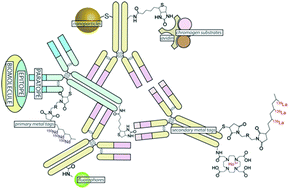当前位置:
X-MOL 学术
›
Chem. Soc. Rev.
›
论文详情
Our official English website, www.x-mol.net, welcomes your
feedback! (Note: you will need to create a separate account there.)
A guide to integrating immunohistochemistry and chemical imaging
Chemical Society Reviews ( IF 40.4 ) Pub Date : 2018-03-15 00:00:00 , DOI: 10.1039/c7cs00610a David P. Bishop 1, 2, 3, 4, 5 , Nerida Cole 1, 2, 3, 4, 5 , Tracy Zhang 4, 5, 6, 7, 8 , Philip A. Doble 4, 5, 6, 7, 8 , Dominic J. Hare 1, 2, 3, 4, 5
Chemical Society Reviews ( IF 40.4 ) Pub Date : 2018-03-15 00:00:00 , DOI: 10.1039/c7cs00610a David P. Bishop 1, 2, 3, 4, 5 , Nerida Cole 1, 2, 3, 4, 5 , Tracy Zhang 4, 5, 6, 7, 8 , Philip A. Doble 4, 5, 6, 7, 8 , Dominic J. Hare 1, 2, 3, 4, 5
Affiliation

|
Chemical imaging provides new insight into the fundamental atomic, molecular, and biochemical composition of tissue and how they are interrelated in normal physiology. Visualising and quantifying products of pathogenic reactions long before structural changes become apparent also adds a new dimension to understanding disease pathogenesis. While chemical imaging in isolation is somewhat limited by the nature of information it can provide (e.g. peptides, metals, lipids, or functional groups), integrating immunohistochemistry allows simultaneous, targeted imaging of biomolecules while also mapping tissue composition. Together, this approach can provide invaluable information on the inner workings of the cell and the molecular basis of diseases.
中文翻译:

免疫组织化学和化学成像整合指南
化学成像为组织的基本原子,分子和生化组成以及它们在正常生理中如何相互关联提供了新的见解。在结构变化变得明显之前就可视化和量化致病反应的产物,这也为理解疾病的发病机理增加了新的维度。尽管孤立的化学成像在一定程度上受到它可以提供的信息性质(例如,肽,金属,脂质或官能团)的限制,但整合免疫组织化学可以同时对生物分子进行靶向成像,同时还能绘制组织组成图。总之,这种方法可以提供有关细胞内部运作和疾病分子基础的宝贵信息。
更新日期:2018-03-15
中文翻译:

免疫组织化学和化学成像整合指南
化学成像为组织的基本原子,分子和生化组成以及它们在正常生理中如何相互关联提供了新的见解。在结构变化变得明显之前就可视化和量化致病反应的产物,这也为理解疾病的发病机理增加了新的维度。尽管孤立的化学成像在一定程度上受到它可以提供的信息性质(例如,肽,金属,脂质或官能团)的限制,但整合免疫组织化学可以同时对生物分子进行靶向成像,同时还能绘制组织组成图。总之,这种方法可以提供有关细胞内部运作和疾病分子基础的宝贵信息。











































 京公网安备 11010802027423号
京公网安备 11010802027423号